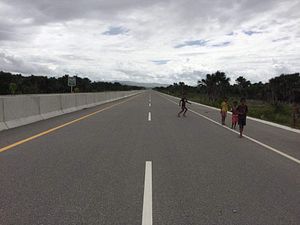In development speak, a “white elephant” is a building project that is extremely expensive but that has little use or practical value.
It would not be a stretch to call Timor-Leste, Southeast Asia’s most democratic nation but also one of its poorest, a graveyard of white elephants. All along Timor-Leste’s southern coast lie the empty shells of multimillion dollar infrastructure projects – new, gleaming, but largely vacant – and the skeletons of those still under construction.
They are part of a larger state-led infrastructure push called the Tasi Mane project. Under Tasi Mane, the government plans to spend $10-14 billion on projects along the southern coast, including a supply base in Suai, a liquid natural gas plant in Beaçu, a refinery in Betano, and centrally planned grid cities in all three towns. The highway will link the projects together.
The ostensible goal of Tasi Mane is to transform Timor-Leste’s undeveloped southern coast into a hub for the petroleum industry. However, to pay for Tasi Mane, the government will have to shell out the majority of its $16 billion petroleum fund. The fund, derived from the revenues of past petroleum projects, provides for around 90 percent of Timor-Leste’s yearly budget. The country is among the most oil-dependent in the world. In other words, like a gambler betting the family silver, the government has decided to put its entire non-renewable natural resource endowment – the money it uses to fund schools, hospitals, the water system, and the police force – on the line.
But Tasi Mane makes little sense from an economic perspective. Every independent expert interviewed for this article agreed that it would be far more efficient for Timor-Leste to simply pipe gas to the already-functional gas liquefaction plant in Darwin, Australia, than to build a new petroleum industry from scratch.
Why, then, is Dili so dead-set on moving forward with Tasi Mane?
At first glance, the empty airport, the deserted highway, and the construction zones pockmarking Timor-Leste’s southern coast might appear to be monuments to government incompetence, the spoiled fruits of a well-meaning development strategy gone wrong.
But James Scambary, an Australian academic and an expert on Timor-Leste, cautions against this reading.
“I’m highly skeptical that there is any development motivation in Tasi Mane,” he says. “It’s about kickbacks. It’s about securing overpriced projects and creaming off the excess. This is what happens at every single level, all the way from a rural toilet to a refinery.”
While the petroleum-funded megaprojects carry few benefits for normal Timorese, they have made certain individuals extraordinarily wealthy. It would thus be more accurate to view them as the byproducts of a successful strategy, one aimed at siphoning money from the country’s closely-guarded petroleum fund and channeling it to a small circle of beneficiaries: corrupt politicians, their friends, families, and allies, and foreign companies on the hunt for lucrative construction contracts.

































